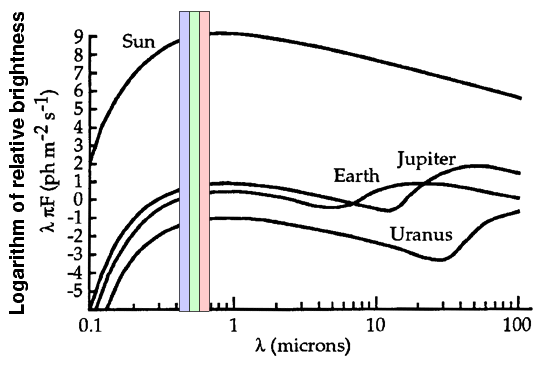
 Copyright © Michael Richmond.
This work is licensed under a Creative Commons License.
Copyright © Michael Richmond.
This work is licensed under a Creative Commons License.
Is there life in the universe beyond our own Solar System? Maybe ... we don't know. It could take many forms, of course, but we would recognize most easily life which resembled life on Earth: creatures which walk, or swim, or fly, on or near the surface of a terrestrial planet. The search for such "ordinary" extraterrestial beings becomes in part the search for "ordinary" Earth-like planets on which they might live. You've probably heard of "SETI" -- the Search for ExtraTerrestial Life -- but what about "SESP" -- the Search for ExtraSolar Planets?
There are at least five techniques astronomers have tried to find planets around other stars. Three of them -- and maybe a fourth -- have succeeded!
The simplest way to find planets around other stars is simply to LOOK for them: point a big telescope at a nearby star and see if there are any faint points of light around the star. Unfortunately, the difference in brightness between even a feeble star and even a giant planet is very, very, very large.

In the visible part of the spectrum, for example, Jupiter is about 8 orders of magnitude fainter than the Sun, and the Earth about 8.5.
Jupiter: 100,000,000 times fainter than the Sun Earth: 300,000,000 times fainter than the Sun
If even a tiny fraction of a star's light is scattered out into the wings of the Point Spread Function (PSF), it may overwhelm any planet in orbit around it. Look at the strong halo of light around this star, for example:
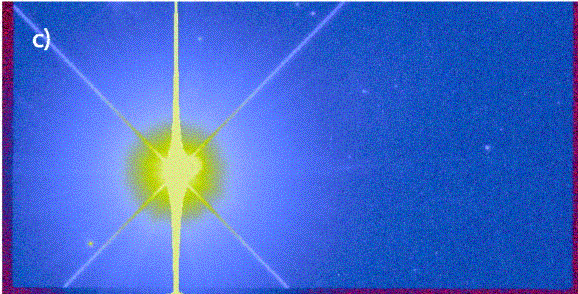
Now, there are tricks one can play to reduce the amount of scattered light. By placing bars, disks, or other opaque objects in the optical path from telescope to camera, one can block most of a star's light. Below is a picture of the coronagraph mask on the STIS camera aboard the Hubble Space Telescope.
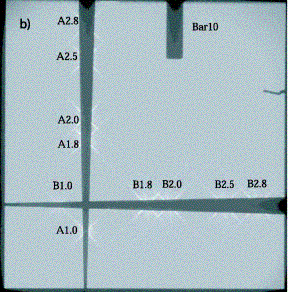
If one points the telescope just right, then the star will fall behind the bar, revealing faint objects close to the star.
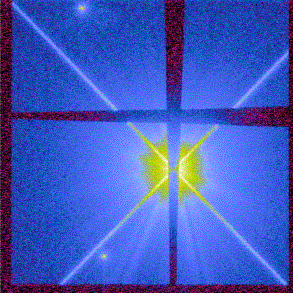
One can reduce the scattered light even more by subtracting a model of the PSF from the image:
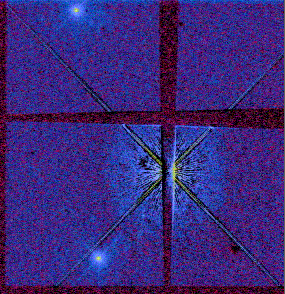
Even so, a significant amount of scattered light does remain...
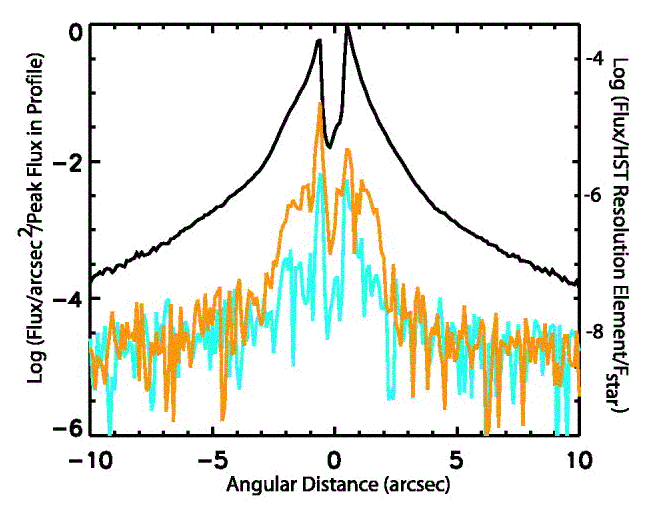
Q: Could STIS distinguish a planet like
Jupiter orbiting around a star like
the Sun?
In September, 2004, astronomers using the European Very Large Telescope announced that they may have detected a very large planet orbiting around another star by direct imaging. They used three techniques to increase their chances of seeing a planet against the glare of its star:
This false-color image shows the star and a faint red object near it:
Now, we aren't yet SURE that this is really a planet orbiting around the star. It could be just another star in the same general direction, either closer or farther away. However, if it does turn out to be a bona fide planetary companion, it is located much farther from its star than the planets in our solar system and probably has about 5 times the mass of Jupiter:
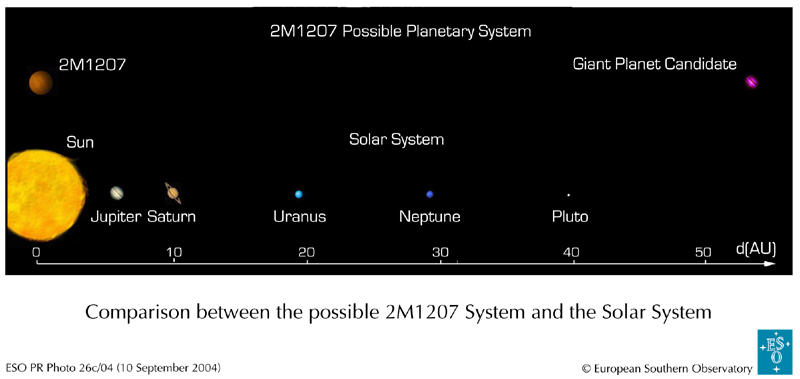
This was one of the first techniques to be used in the search for extrasolar planets. It's pretty simple: one takes pictures of a nearby star over and over and over again, for a decade or more. Many nearby stars will slowly drift relative to more distant stars, due to the combination of their own motion through space and the Sun's motion, too. Barnard's Star, for example, moves about 10 arcseconds per year, or about one degree every 360 years.
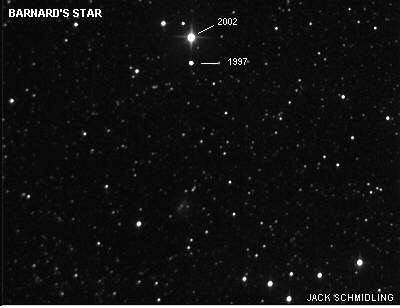
In the 1960s, after many years of carefully measuring the position of Barnard's Star, astronomer Peter van de Kamp announced that its path through the sky was not a straight line, but had periodic wobbles:
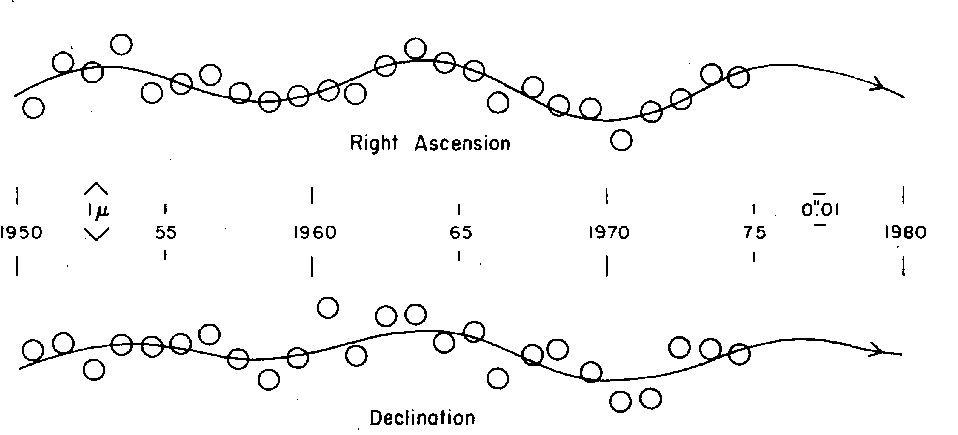
Taken from Figure 1 of
Astrometric study of Barnard's star from plates taken with
the Sproul 61-cm refractor AJ 80, 658 (1975)
He interpreted these wobbles as small motions of the star caused by the gravitational attraction of two planets orbiting around it.
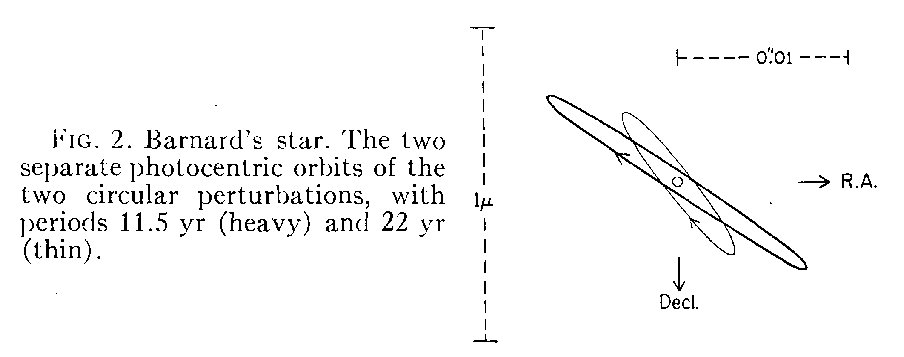
Taken from Figure 2 of
AJ 80, 658 (1975)
Clearly, the method works best when the wobbles in the star's motion are large, which in turn implies that the planet's orbit is large. Large orbits mean long periods, so one must be patient to use this method. In addition, measuring the shift in POSITION of a star isn't easy, and it gets harder as one examines more distant stars. The size of the apparent shift in position decreases with distance: a star twice as far away will appear to wobble half as much. We can apply this technique only to nearby stars.
Unfortunately, further measurements of Barnard's Star showed that the wobbles van de Kamp had measured didn't repeat.
At the moment, no planets have been detected by this technique, although many low-mass binary stars have been found.
Astronomers have used binary stars to calculate stellar masses for years. The basic idea is
Astronomers occasionally found companion stars which were completely invisible by this method. But no one had used it to look for planets, because the size of the shifts in wavelength would be very, very small ... too small to measure.
About a decade ago, as radio astronomer Alexander Wolszczan studied a pulsar, he noticed a peculiar periodic shift in the arrival times of its pulses.
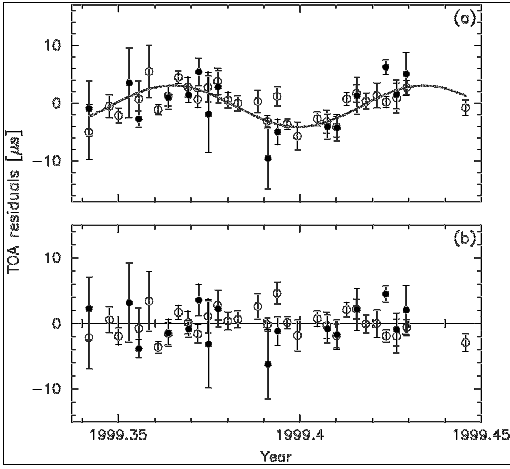
The shifts in the arrival times indicated that there were several planets going around the pulsar. After several more years of observations, we have settled on three planets, all much closer to their pulsar than the Earth is to our Sun.
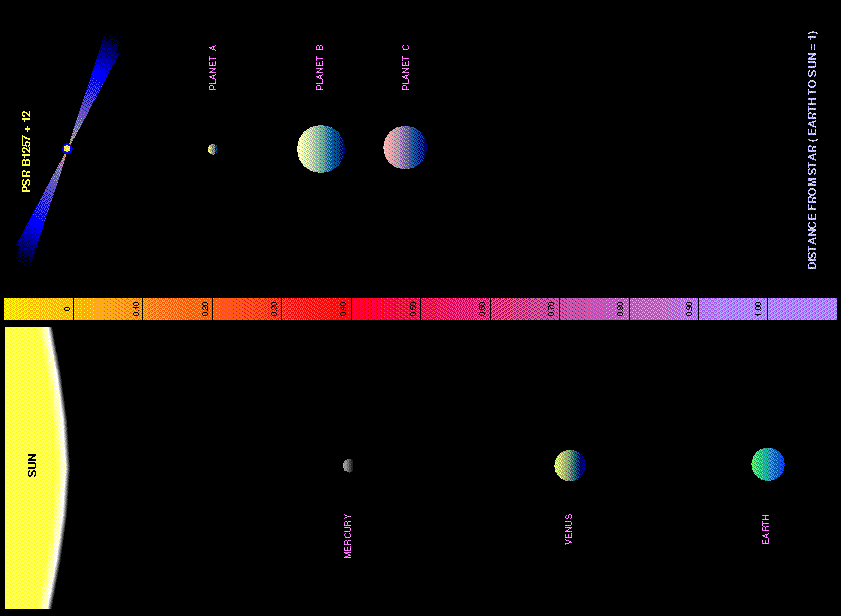
These were the first planets discovered around any other star. They didn't seem very comfortable, though ...
Spurred by this discovery, several groups of astronomers decided to build better spectrographs, capable of detecting the tiny shifts in wavelength which planets might cause.
One of these groups was based in France. They used a relatively small telescope, with a mirror only 1.93 meters in diameter, to look at nearby bright stars. The telescope sent light from the stars to a spectrograph called "ELODIE", which broke it up into many rows:
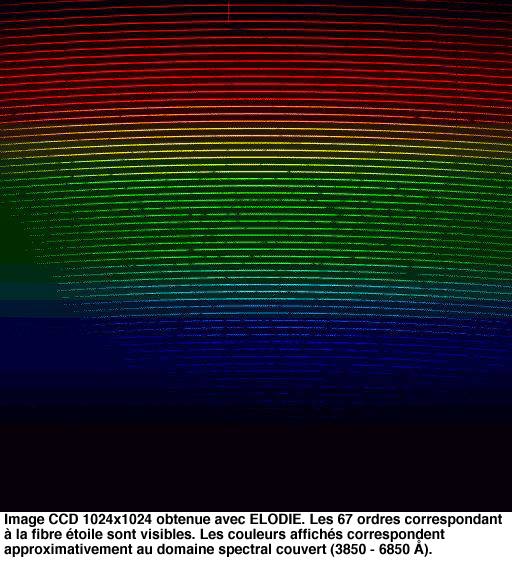
Because their spectrograph covered nearly the entire visible spectrum at once, the astronomers of the Haute-Provence Observatory were able to measure the positions of THOUSANDS of lines, not just the hundred or so that traditional spectrographs provided. By averaging these thousands of measurements, they were able to reach higher precisions ... which meant they could detect smaller radial velocity variations. On October 6, 1995, Michel Mayor and Didier Queloz announced that the star 51 Pegasi was wobbling due to the motion of a planet orbiting around it:

The size of the radial velocity variations was about 60 meters per second.
Q: What was the shift in wavelength of the Hydrogen-alpha absorption line?
The planet was about half the mass of Jupiter -- nothing surprising there -- but, bizarrely, it was MUCH closer to its star than any of the planets in our Solar System:
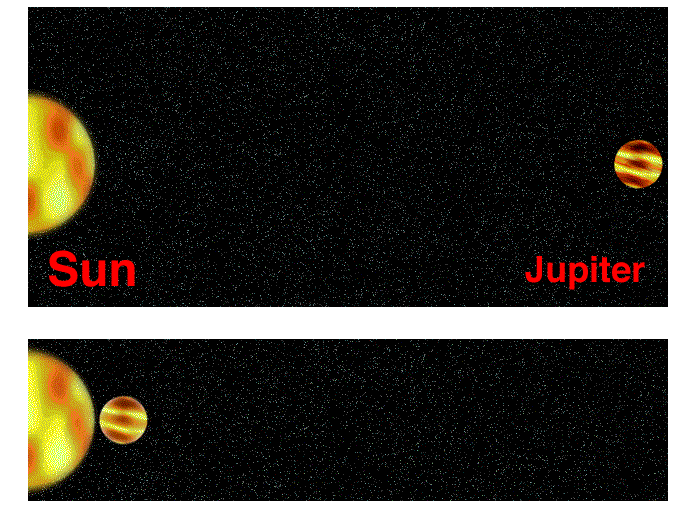
The same radial velocity technique has been used by other groups in the past decade to discover over 100 planets around other stars. Strangely enough, almost all of them also revolve around their host stars in very small orbits:
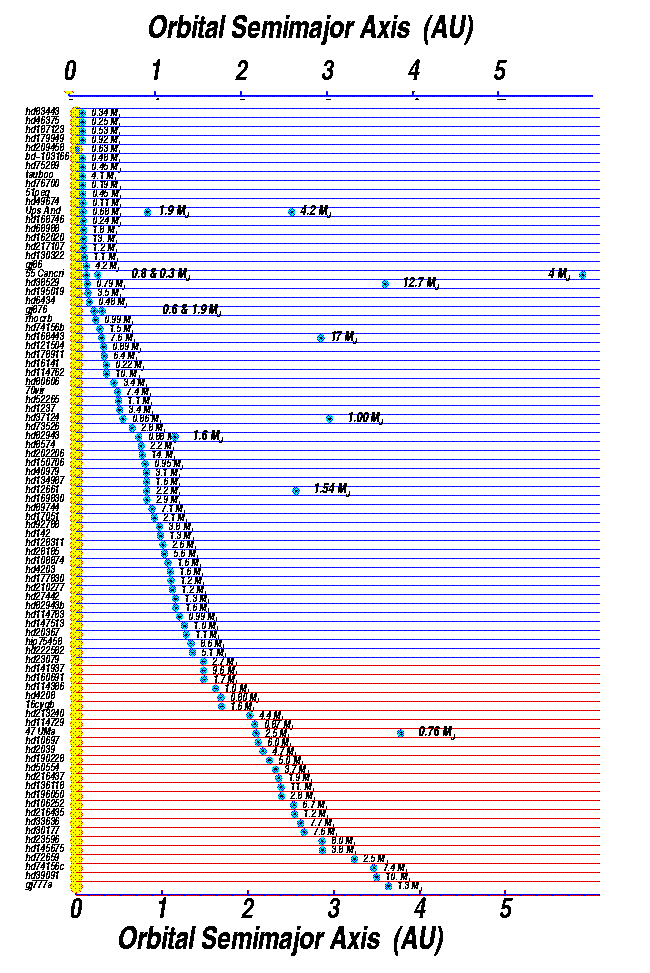
But wait a minute -- is this really so strange? No, not really; it's an example of a selection effect. The radial-velocity technique looks for changes in a star's velocity due to the gravitational force of a planet. That force is largest when the planet is very close to the star. Moreover, if one is looking for some periodic variation
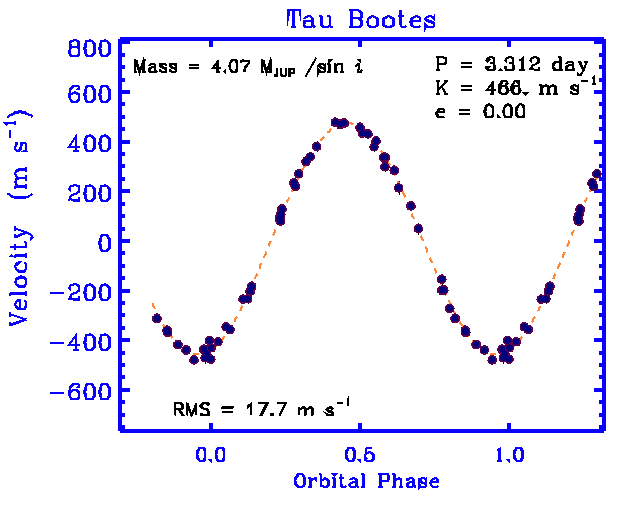
it's a lot easier to see if it occurs over a week or two. If the planet's orbit is five years long -- like Jupiter's -- then one will have to continue measuring the star's radial velocity for FIVE YEARS in order to see a single cycle. Most astronomers would want to see two or three complete cycles before they made any announcements, so they would have to wait FIFTEEN YEARS.
Q: How long have these groups been making high-precision radial velocity measurements?
The radial-velocity technique works best for massive stars in small orbits. It's the most productive method we have to find planets around other stars, accounting for over ninety percent of all discoveries so far.
If the orbit of a planet around another star happens to be edge-on, then once during every revolution, the planet will pass in front of its star in what is called a transit.
Since it blocks a small portion of the star's photosphere, it will decrease the light from the star for a brief period -- typically a few hours. The size of the dimming depends on the relative sizes of the star and planet:
big star, small planet --> small dip small star, big planet --> big dip
You can see from this picture of the transit of Venus across the face of the Sun, taken in June, 2004, that terrestrial planets won't produce much of an effect (especially since the relative size of Venus is somewhat magnified due to its proximity to Earth).
Obviously, this technique works best for finding big planets.
Q: How large a dip in the light of the Sun would Jupiter cause if it passed in front?
Even small telescopes can make precise measurements of the light from a star (if one works hard to remove instrumental effects). The STARE Project, for example, uses a telescope with a diameter of just five inches:

Several years ago, this little telescope was pointed to the star HD 209458, which was already known to have a planet via the radial velocity technique. As it watched, the star's light decreased briefly ...
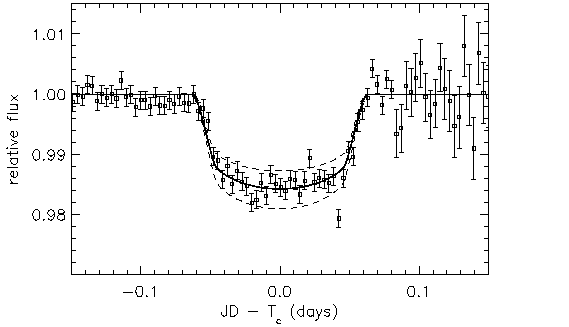
Note the size of the effect: less than two percent. It is difficult to measure such a small dip, but not impossible. In fact, we've detected a transit by another extra-solar planet with the equipment here at the RIT Observatory.
Several groups are now using similar small telescopes to look over and over and over and over and OVER again at the same place in the sky. They hope to find a little dip in the light from a star; but, in order to confirm that it really is due to a planet, they must keep watching to see a second dip ... and then a third ... and a fourth, all with the same period between. It's a tough business, but probably the cheapest way to find a planet around another star.
One group has hit paydirt! The Optical Gravitational Lensing Experiment (or OGLE, for short) has been using a 1.3-m telescope in Chile to monitor very rich star fields in the bulge of the Milky Way for several years. Their pictures contain a LOT of stars:
Recently, they have started to search through their very large dataset for small, periodic dips in the brightness of each star. In 2003, they announced the first extrasolar planet to be discovered via its transit: OGLE-TR-56:

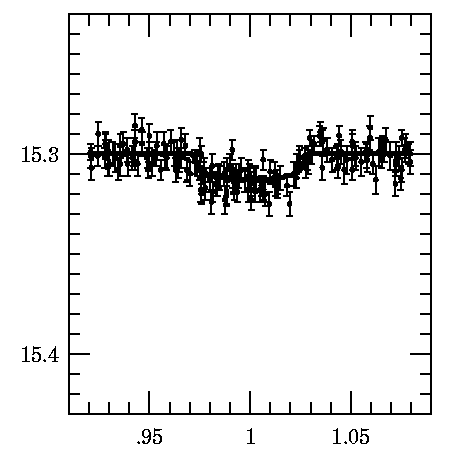
Q: What fraction of the star's disk does
this planet cover?
Is the planet bigger or smaller than Jupiter?
The OGLE team has many, many more candidates of events which may be due to transiting planets: this diagram appeared on their WWW page on Nov 7, 2004:
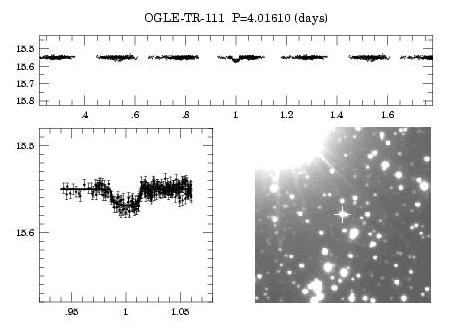
You know that gravity affects the motion of ordinary objects: the gravitational force of the Sun, for example, causes the Earth to move around it in a roughly circular orbit. It turns out that gravity can also alter the path of a beam of light.

This gravitational lensing is very rare: it requires that the source of light, massive lensing object, and observer all be lined up nearly perfectly. However, astronomers have been searching for these very rare situations for a decade now; there are many tens of systems known, and new ones discovered every year.
In some cases, relative motion of the foreground lensing object and the background source creates a strong lensing effect which gradually dies away as the objects fall out of line:
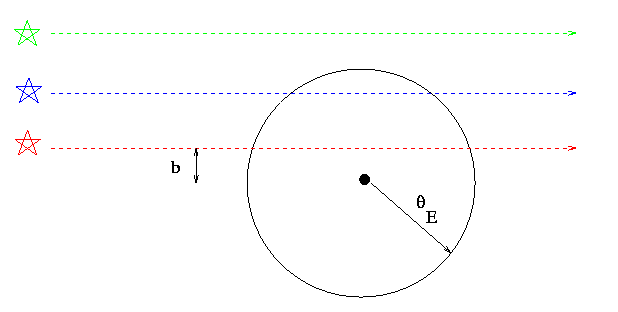
The lensing causes the background object to appear far above its normal brightness, then fall back down to the regular level:
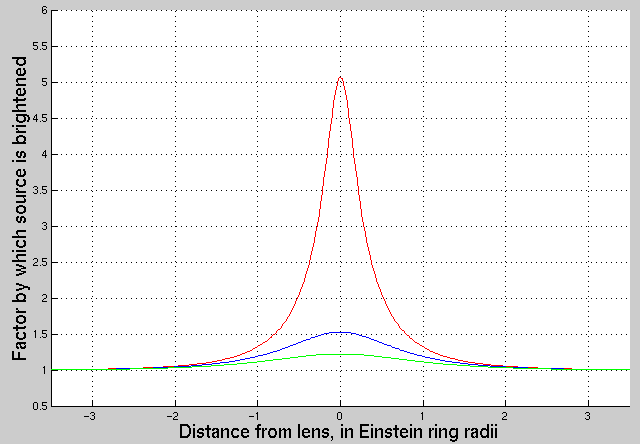
The The Optical Gravitational Lensing Experiment (or OGLE, for short) group has searched for such systems and found many:
Note the regular, symmetric form of this light curve caused by gravitational lensing.
Now, recently, the OGLE and MOA groups noticed a very strange event: it didn't look like the usual symmetric increase and decrease at all:

What could cause those two sharp "spikes" in the light curve? Possible -- a planet! If one combines the gravitational effects of a star PLUS a planet, arranged just right, one can explain the two sharp, short increases in brightness.
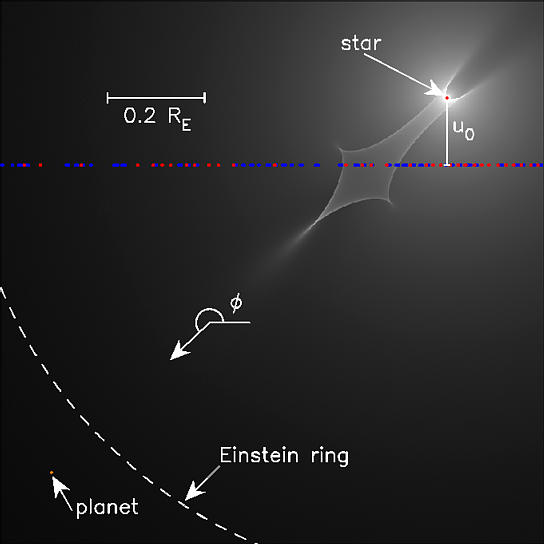
For more details, read this page about OGLE 2003-BLG-235/MOA 2003-BLG-53
Method works best for found any planets yet?
------------------------------------------------------------------------------
Direct imaging big planets far from star one good suspect
Astrometric wobble massive planets far from star no
Radial velocity massive planets close to star yes, lots
Photometry big planets close to star several confirmed,
lots of suspects
Gravitational lensing (no strong bias) several suspects
-----------------------------------------------------------------------------
 Copyright © Michael Richmond.
This work is licensed under a Creative Commons License.
Copyright © Michael Richmond.
This work is licensed under a Creative Commons License.